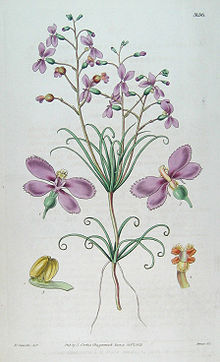
Stylidium is a genus of dicotyledonous plants that belong to the family Stylidiaceae. The genus name Stylidium is derived from the Greek στύλος or stylos, which refers to the distinctive reproductive structure that its flowers possess. Pollination is achieved through the use of the sensitive "trigger", which comprises the male and female reproductive organs fused into a floral column that snaps forward quickly in response to touch, harmlessly covering the insect in pollen. Most of the approximately 300 species are only found in Australia, making it the fifth largest genus in that country. Triggerplants are considered to be protocarnivorous or carnivorous because the glandular trichomes that cover the scape and flower can trap, kill, and digest small insects with protease enzymes produced by the plant. Recent research has raised questions as to the status of protocarnivory within Stylidium.

The family Stylidiaceae is a taxon of dicotyledonous flowering plants. It consists of five genera with over 240 species, most of which are endemic to Australia and New Zealand. Members of Stylidiaceae are typically grass-like herbs or small shrubs and can be perennials or annuals. Most species are free standing or self-supporting, though a few can be climbing or scrambling.
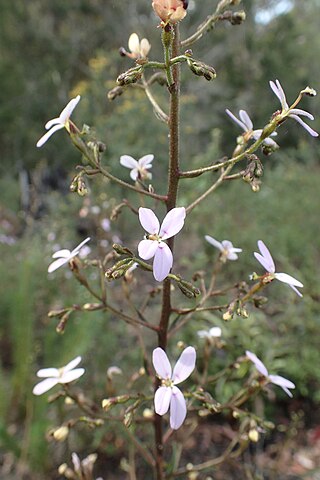
Stylidium laricifolium, commonly known as giant trigger-plant, larch-leaf or tree triggerplant, or is a species of flowering plant in the family Stylidiaceae and is endemic to eastern Australia. It is a perennial subshrub with many linear leaves crowded along its few stems, the flowers white to pale pink and arranged in a single main panicle and smaller racemes.
Juliet Ann Wege is an Australian botanist. She graduated in 1992 and gained a PhD at The University of Western Australia in 1999 with a thesis titled "Morphological and anatomical variation within Stylidium (Stylidiaceae): a systematic perspective". As of 2021 she works as a researcher at the Western Australian Herbarium run by Western Australia's Department of Biodiversity, Conservation and Attractions and is managing editor of Nuytsia. Her main area of expertise is in taxonomy and study of the Stylidiaceae family of triggerplants.

Stylidium repens, the matted triggerplant, is a dicotyledonous plant that belongs to the genus Stylidium. S. repens is endemic to Australia and is found primarily in southwest Western Australia. This species is a creeping or scrambling triggerplant, which can spread over large areas as a tangled mat of stems and aerial roots. The older stems are grey whereas younger stems appear red and have terminal rosettes of small leaves, five mm to one cm in length. When the rains come, new roots and a one to three flowers emerge from the terminal rosettes. This is the only species of triggerplant known to regularly flower twice a year—in autumn and late spring. Pollination, which is typically very specialized in this genus, is achieved with a variety of insects in this species.

Stylidium turbinatum is a dicotyledonous plant that belongs to the genus Stylidium. S. turbinatum is endemic to Australia and is found in the northern part of Western Australia in the Kimberley region and near Darwin in the Northern Territory. This species is an erect annual herb that stands 6–15 cm tall. A 2–5 cm long stem bearing scattered leaves terminate in a tuft of 1–2 cm long upper leaves. Several scapes appear from these terminal tufts. The inflorescence is a raceme, which produces pink flowers whose petals are vertically paired. The hypanthium of this species is turbinate and is one of the distinguishing characteristics used to identify it. The sepals form ribs around the hypanthium, giving it a turbine-like appearance. Seeds of S. turbinatum are pale orange and around 0.2 mm long. S. turbinatum was first formally described by Allen Lowrie and Kevin F. Kenneally in 1997, with most specimens having been collected and examined in the mid-1990s with one early specimen from 1990. S. turbinatum grows in sandy soils at the margins of creeks and floodways and is closely associated with wet season herb fields.

Stylidium graminifolium, the grass triggerplant, is a dicotyledonous plant that belongs to the genus Stylidium. This species used to belong to the Stylidium graminifolium complex, but the name was conserved for this single species when two others were split from the complex and introduced as new species in 2001. S. graminifolium is endemic to Australia and is the Stylidium species with the widest distribution throughout Australia. It is a perennial plant with grass-like leaves and is easily cultivated. It has been considered to be a carnivorous or protocarnivorous plant because it possesses glandular trichomes underneath the flowers that can trap and digest prey.

Oreostylidium is a genus of flowering plants in the family Stylidiaceae with a single species, Oreostylidium subulatum, that is endemic to New Zealand. O. subulatum is a very small plant with small, white flowers. It has a complicated botanical history that has led to a few proposals to move Oreostylidium to the related genus Stylidium. The researchers cite molecular data and suspect that this species is an extreme example of floral paedomorphosis. This would not be an unprecedented move since the single species was initially described as Stylidium subulatum in 1864 and later moved to its own genus by Sven Berggren in 1878. It possesses the same kind of glandular trichomes underneath the flower that make Stylidium species carnivorous plants, but it has not yet been tested for the presence of digestive enzymes.

Donatia is a genus of two cushion plant species in the family Stylidiaceae. The name commemorates Vitaliano Donati, an Italian botanist.
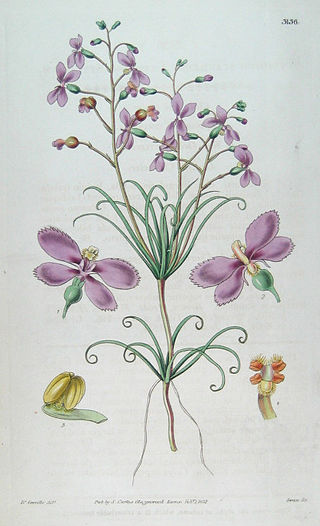
Verticillatae is a section in the subgenus Tolypangium that is characterized by globose capsules. Recent genetic analysis, combined with an exhaustive morphological comparison, has revealed that the classification defined by Johannes Mildbraed in 1908 is not the most accurate description of how the members of different subgenera and sections are related. As part of the Flora of Australia series, Juliet Wege will be reviewing and updating the taxonomy of the Stylidiaceae.
Repentes is a section in the subgenus Tolypangium. Repentes is a group of creeping triggerplants known as the locket triggerplants, related to subgenus Nitrangium section Appressae. They possess adpressed stem leaves bearing a small basal spur and uni-flowered inflorescences. Because section Repentes morphologically resembles the other creeping triggerplants in section Appressae, Allen Lowrie et al. (1999) proposed all species in this section be moved to section Appressae and Repentes be placed into synonymy. Juliet Wege (2006), however, argued that these species are morphologically distinct from those in section Appressae, citing trichome and column cunabulum structure as distinctions that separate the sections.
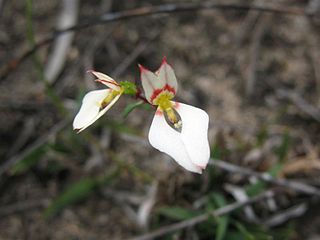
Levenhookia, also known as the styleworts, is a genus of ten recognized species in the family Stylidiaceae and is endemic to Australia. The genus is restricted to Western Australia almost exclusively with a few exceptions: L. pusilla's range extends into South Australia, L. dubia's range extends through South Australia into Victoria and New South Wales, L. sonderi is native only to Victoria, and L. chippendalei is also found in the Northern Territory.
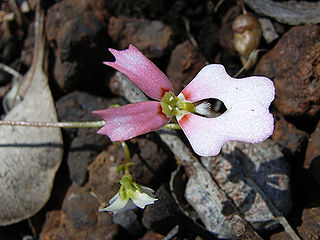
Stylidium subg. Centridium is a subgenus of Stylidium that is characterized by a globose hypanthium, a stipitate brush-like stigma, and gynostemium mobility not produced by a sensitive hinged torosus but by the movement of a cunabulum. All species with the possible and doubtful exception of S. weeliwolli are annuals. This subgenus appears to be most closely related to the genus Levenhookia, which suggests an ancestral relationship. Centridium was first published by John Lindley in the 1839 publication, A Sketch of the Vegetation of the Swan River Colony. Lindley created this subgenus to distinguish species which did not fit into either of the two other subgenera that had existed at the time. He initially placed Stylidium calcaratum, the newly described Stylidium androsaceum, and Stylidium stipitatum into subgenus Centridium. His description of S. androsaceum turned out to be synonymous with S. calcaratum and S. stipitatum is a synonym of Levenhookia stipitata.
Stylidium subg. Forsteropsis, as circumscribed by Allen Lowrie and Kevin Kenneally, contains five species of triggerplants from south-western Australia that are characterized by their tightly appressed leaves arranged in a spiral around the stem. This subgenus was originally described by Otto Wilhelm Sonder in 1845 as the genus Forsteropsis.
Stylidium imbricatum, the tile-leaved triggerplant, is a dicotyledonous plant that belongs to the genus Stylidium. It is an herbaceous perennial that grows from 12 to 50 cm tall and has divided stems covered with tile-like leaves that are arranged in a spiral formation around the stem. The ovate-elliptic leaves are basifixed and held closely against the stems. The leaves are around 1.5-1.8 mm long and 0.6-0.8 mm wide. Terminal inflorescences are racemose or spike-like and produce flowers that are reddish violet with laterally-paired lobes and bloom from April to May in their native range. S. imbricatum is only known from south-western Western Australia in Stirling Range National Park and Porongurup National Park south-east to Cheynes Beach. Its habitat is recorded as being sandy or laterite soils in swampy areas, rocky slopes, or heathland. S. imbricatum is distinct within its subgenus because it possesses obovate sepals. Its conservation status has been assessed as secure.
Stylidium preissii, the lizard triggerplant, is a species that belongs to the genus Stylidium. It is an herbaceous perennial that grows from 5–18 cm tall and has divided stems covered with tile-like leaves that are arranged in a spiral formation around the stem. The broadly trullate leaves are basifixed and held closely against the stems. The leaves are around 1.9 mm long and 1.0 mm wide. Inflorescences are umbellate racemes and produce flowers that are white, pale pink, or dark pink and bloom from November to December in their native range. S. preissii is only known from south-western Western Australia from Bremer Bay to Israelite Bay with a few populations near Jandakot. Its habitat is recorded as being white sandy soils in open heathland. S. preissii is distinct within its subgenus because it possesses a strap-like gynostemium column with a dilated cunabulum.

Donatia novae-zelandiae is a species of mat-forming cushion plant, found only in New Zealand and Tasmania. Common names can include New Zealand Cushion or Snow Cushion, however Snow Cushion also refers to Iberis sempervirens. Donatia novae-zelandiae forms dense spirals of thick, leathery leaves, creating a hardy plant that typically exists in alpine and subalpine bioclimatic zones.

Stylidium affine is a species in the genus Stylidium that is endemic to Western Australia.

Stylidium asymmetricum, the asymmetric triggerplant, is a flowering plant species of the genus Stylidium and is endemic to south-west Western Australia. It is an annual plant from 2 to 16 cm high that grows at the margins of swamps in clay soils. It is only known from two populations in the Northern Jarrah Forest south-west of York and thus it was listed as Priority Two under the Declared Rare and Priority Flora List and more work is necessary to determine the population stability and existing threats, such as feral pigs and off-road vehicles, to the plants. The species epithet asymmetricum refers to the marked asymmetrical corolla arrangement, where the uppermost posterior lobe and the uppermost anterior lobe of the corolla meet at nearly a 90-degree angle, giving the flower a lopsided appearance.
Stylidium exappendiculatum is a species of dicotyledonous plant in the genus Stylidium.
